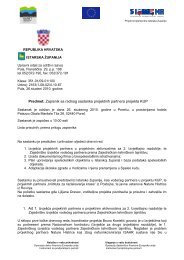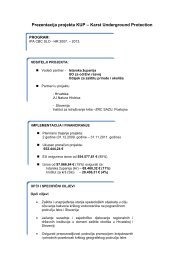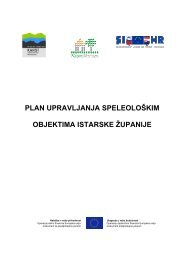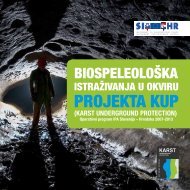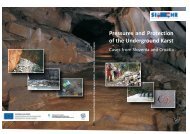Case Studies from the Dinaric Karst of Slovenia
Case Studies from the Dinaric Karst of Slovenia
Case Studies from the Dinaric Karst of Slovenia
You also want an ePaper? Increase the reach of your titles
YUMPU automatically turns print PDFs into web optimized ePapers that Google loves.
The o<strong>the</strong>r problem <strong>of</strong> karst is water, especiallyalong Adriatic coast where <strong>the</strong> highestlack <strong>of</strong> water occurs during summer. Thisis a result <strong>of</strong> low amount or precipitation andhigh evapotranspiration. For <strong>the</strong> water supply,some aqueducts were made in antiquity (Bonacci1987). More common are wells, whichwere <strong>of</strong>ten built in closed depresions (Fig. 35).Fig. 36: During Austro-Hungarian Empire and Yugoslaviakingdom surface streams were regulated, ponors were widenedand screens were installed in front <strong>of</strong> <strong>the</strong>m to holdback deposits, all in order to shorten <strong>the</strong> flood time in karstpoljes. Example <strong>from</strong> Šica ponor at Radensko polje (Račnapolje; <strong>Slovenia</strong>; photo: M. Prelovšek).A greater impact was made by <strong>the</strong> irrigation<strong>of</strong> some poljes to avoid long lasting floods.They enlarged ponors on poljes and even dugsome tunnels for <strong>the</strong> floodwaters. None <strong>the</strong>less, enlargement <strong>of</strong> ponors successfully reduced<strong>the</strong> length <strong>of</strong> floods only at places,where a restristions were close to <strong>the</strong> ponors.At places with regional rise <strong>of</strong> water level, enlargement<strong>of</strong> ponors brought only minor success.However, <strong>the</strong> main impact on <strong>the</strong> karst wasmade by <strong>the</strong> use <strong>of</strong> waters in power stations.Especially high mountainous karst has beenvery interesting <strong>from</strong> <strong>the</strong> hydroenergeticsaspect due to a high amount <strong>of</strong> precipitation,high run<strong>of</strong>f coefficient (about 0.7), high reliefamplitude and relief suitability. Especiallyduring <strong>the</strong> 1950s and 1960s, big hydroenergeticprojects were initiated on <strong>Dinaric</strong> karst poljesin Croatia, Bosnia and Herzegovina. Largeworks were done in <strong>the</strong> Trebišnjica river karstby flooding part <strong>of</strong> <strong>the</strong> karst (Fig. 37 and 38),by diverting water to o<strong>the</strong>r catchment areas(Fig. 39) and stopping regular flooding <strong>of</strong> <strong>the</strong>Popovo polje (Milanovič 2006). Importanthydroenergetic objects were placed also inCetina, Lika-Gacka and Zeta river basins. In<strong>the</strong> present day situation, hydroelectric powerplants in <strong>the</strong> <strong>Dinaric</strong> karst have a total installpower <strong>of</strong> over 2,727 MW. Never<strong>the</strong>less, <strong>the</strong>level <strong>of</strong> environmental concern about someareas (e.g., Planinsko polje, Cerkniško polje,Pivka basin, Reka valley, and <strong>the</strong> Kupa/KolpaRiver) was so high that <strong>the</strong>se areas remainhydroenergetically untouched.Fig. 37: Hutovo accumulation lake at <strong>the</strong> downstream end <strong>of</strong> Popovo polje (on <strong>the</strong> right), Herzegovina (photo: M. Prelovšek).47



